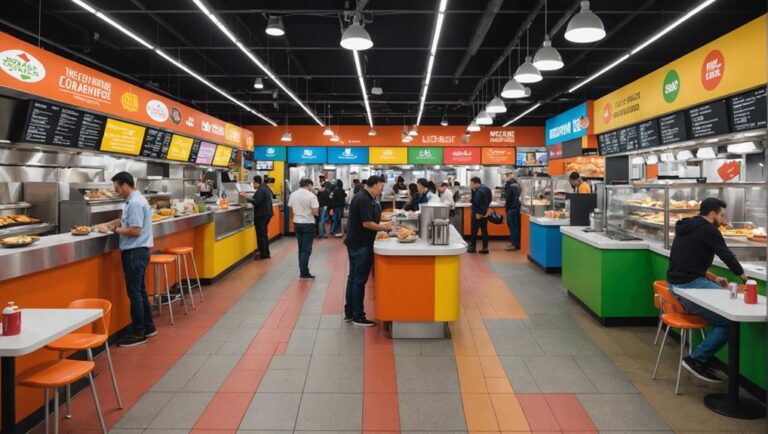Berührungsempfindliche Böden sind eine bahnbrechende Innovation für Smart Homes und verwandeln Ihre Böden in interaktive Oberflächen, die Sicherheit und Komfort erhöhen. Integrierte Sensoren erfassen Druck und Bewegung und integrieren sich nahtlos in Ihre Smart-Home-Systeme. Diese Technologie ermöglicht Echtzeitwarnungen, passt die Beleuchtung automatisch an und kann sogar zwischen Familienmitgliedern und Eindringlingen unterscheiden. Profitieren Sie von zusätzlichen Sicherheitsfunktionen wie Sturzerkennung und anpassbaren Reaktionen, die Ihre Gewohnheiten lernen. Mit verschiedenen Materialien und Designs erfüllt er auch Ihre ästhetischen Ansprüche. Entdecken Sie, wie diese Technologie Ihren Wohnraum in eine reaktionsschnellere Umgebung verwandelt.
Was ist ein berührungsempfindlicher Bodenbelag?
Berührungsempfindliche Böden stellen einen bahnbrechenden Fortschritt in der Smart-Home-Technologie dar und integrieren taktile Interaktion in alltägliche Wohnräume. Dieses innovative Bodensystem nutzt fortschrittliche Sensoren, die in verschiedene Bodenmaterialien integriert sind, um Druck und Bewegung zu erfassen. Beim Betreten der Oberfläche wird eine Berührungsreaktion ausgelöst, die eine nahtlose Steuerung Ihres Zuhauses ohne herkömmliche Schalter oder Bedienelemente ermöglicht.
Die in diesen Systemen verwendeten Bodenbeläge variieren stark, von strapazierfähigem Vinyl bis hin zu elegantem Hartholz. So wird sichergestellt, dass Ästhetik und Funktionalität gleichermaßen erhalten bleiben. Diese Materialien sind so konstruiert, dass sie den Belastungen des Alltags standhalten und gleichzeitig die für berührungsempfindliche Technologie erforderliche Reaktionsfähigkeit bieten.
Einer der Hauptvorteile berührungsempfindlicher Bodenbeläge ist ihr Potenzial, die Sicherheit in Ihrem Zuhause zu erhöhen. So können Sie beispielsweise bestimmte Bereiche so programmieren, dass beim Betreten eines dunklen Raums das Licht aktiviert wird. Das reduziert das Sturz- und Unfallrisiko. Darüber hinaus können diese Systeme mit Sicherheitsfunktionen ausgestattet werden, die Sie beispielsweise benachrichtigen, wenn jemand Sperrbereiche betritt.
Darüber hinaus sorgen berührungsempfindliche Böden für ein intuitiveres Wohnerlebnis. Heiz- und Kühlsysteme lassen sich ganz einfach mit einem einfachen Schritt oder Wisch steuern. Das fördert die Energieeffizienz und erhöht den Komfort. Die Technologie unterstützt auch Menschen mit eingeschränkter Mobilität, da sie das Greifen oder Bücken zur Bedienung der Bedienelemente überflüssig macht.
So funktionieren berührungsempfindliche Bodenbeläge
Berührungsempfindliche Bodenbeläge arbeiten mit fortschrittlicher Sensortechnologie, die Druck und Bewegung erkennt. Sobald Sie diese Oberflächen betreten, übermitteln eingebettete Sensoren Informationen an Ihr Smart-Home-System und ermöglichen so eine Reihe von Anwendungen, von Sicherheitswarnungen bis hin zu automatisierter Beleuchtung. Dieser innovative Bodenbelag erhöht nicht nur den Komfort, sondern verändert auch die Art und Weise, wie Sie mit Ihrem Wohnumfeld interagieren.
Sensortechnologie erklärt
In modernen Smart Homes spielt innovative Sensortechnologie eine entscheidende Rolle bei der Entwicklung berührungsempfindlicher Bodensysteme. Diese Systeme nutzen verschiedene Sensortypen, wie kapazitive, resistive und piezoelektrische Sensoren, um Druck und Berührung zu erfassen. Wenn Sie auf den Boden treten, BodenDiese Sensoren reagieren, indem sie Änderungen der elektrischen Kapazität oder des Widerstands messen und so eine sofortige Rückmeldung zu Ihrer Bewegung geben.
Technologische Fortschritte haben die Genauigkeit und Zuverlässigkeit dieser Sensoren deutlich verbessert. Beispielsweise können kapazitive Sensoren nun selbst leichte Berührungen erkennen und so eine reibungslosere Interaktion mit Smart-Home-Funktionen ermöglichen. Darüber hinaus können piezoelektrische Sensoren aus Druck Energie erzeugen und so effizient und nachhaltig arbeiten.
Sicherheit steht bei der Integration solcher Technologien in Ihr Zuhause an erster Stelle. Diese Bodensysteme sind so konzipiert, dass Fehlauslösungen minimiert werden und nur bewusste Berührungen Reaktionen auslösen. Darüber hinaus können die Sensoren so programmiert werden, dass sie nahtlos mit anderen Smart-Home-Geräten zusammenarbeiten und so bewegungsbasierte Alarme und Benachrichtigungen auslösen. Wenn Sie die zugrunde liegende Sensortechnologie verstehen, können Sie erkennen, wie berührungsempfindliche Bodenbeläge nicht nur den Komfort erhöhen, sondern auch zu einem sichereren Wohnumfeld beitragen.
Anwendungen im Smart Home
Die Integration fortschrittlicher Sensortechnologie in Bodensysteme eröffnet vielfältige Anwendungsmöglichkeiten im Smart Home. Berührungsempfindliche Böden können Ihr Wohnumfeld deutlich verbessern, indem sie Echtzeitdaten und reaktionsschnelle Funktionen liefern, die Sicherheit und Wohlbefinden fördern. Beim Betreten dieser Spezialböden erkennen eingebettete Sensoren Druck und Bewegung, sodass das System entsprechend reagieren kann.
Eine der überzeugendsten Anwendungen ist die Gesundheitsüberwachung. Durch die Analyse Ihrer Bewegungsmuster kann der Bodenbelag Ihr Aktivitätsniveau verfolgen und Sie auf Veränderungen aufmerksam machen, die auf gesundheitliche Probleme wie Stürze oder eingeschränkte Mobilität hinweisen können. Diese Funktion ist besonders für ältere oder behinderte Menschen von Vorteil und gibt Pflegekräften und Angehörigen Sicherheit.
Darüber hinaus bietet der berührungsempfindliche Bodenbelag verschiedene Sicherheitsfunktionen. So kann er beispielsweise die Beleuchtung automatisch anpassen oder den Notdienst alarmieren, wenn er einen Sturz erkennt. Der Bodenbelag kann außerdem so programmiert werden, dass er bestimmte Schritte erkennt und so zwischen Familienmitgliedern und potenziellen Eindringlingen unterscheidet. Das erhöht die Sicherheit Ihres Zuhauses.
Vorteile berührungsempfindlicher Bodenbeläge
Berührungsempfindliche Böden verbessern Ihr Nutzungserlebnis erheblich, indem sie eine intuitive Interaktion mit Ihren Smart-Home-Systemen ermöglichen. Dank der Fähigkeit, unterschiedliche Drucke und Gesten zu erkennen, ermöglicht er eine nahtlose Steuerung von Beleuchtung und Geräten und passt Ihre Umgebung so besser an Ihre Bedürfnisse an. Darüber hinaus kann diese Technologie die Energieeffizienz verbessern, indem sie die Ressourcennutzung basierend auf Ihren Bewegungen und Vorlieben optimiert.
Verbesserte Benutzererfahrung
Berührungsempfindliche Bodenbeläge, oft übersehen, verbessern das Benutzererlebnis in Smart Homes erheblich, indem sie intuitive Interaktion und nahtlose Steuerung verschiedener Funktionen ermöglichen. Diese innovative Technologie ermöglicht Ihnen eine natürliche und sichere Interaktion mit Ihrer Umgebung und bietet Ihnen wichtiges taktiles Feedback beim Navigieren durch den Raum.
Hier sind einige wichtige Vorteile, die Ihr Erlebnis verbessern:
- Intuitive Steuerung: Sie können mühelos die Beleuchtung und Temperatur anpassen und sogar Musik abspielen, indem Sie einfach auf bestimmte Bereiche Ihres Bodens treten oder darauf tippen.
- Verbesserte Sicherheit: Der Bodenbelag kann so gestaltet werden, dass er nur auf bestimmte Druckstufen reagiert. Dadurch wird sichergestellt, dass versehentliche Aktivierungen minimiert werden, was insbesondere für Haushalte mit Kindern oder Haustieren von Vorteil ist.
- Zugänglichkeit: Berührungsempfindliche Bodenbeläge können besonders für Personen mit eingeschränkter Mobilität hilfreich sein, da sie ihnen ermöglichen, ihre Umgebung zu steuern, ohne nach Schaltern oder Fernbedienungen greifen zu müssen.
- Anpassbare Einstellungen: Sie können Ihren Bodenbelag individuell gestalten, sodass er je nach Tageszeit oder bestimmten Aktivitäten anders reagiert und Ihr Zuhause besser auf Ihren Lebensstil abstimmt.
Mit berührungsempfindlichen Böden erleben Sie eine harmonische Mischung aus Komfort und Innovation und sorgen so für ein benutzerfreundliches und sicheres Zuhause.
Verbesserung der Energieeffizienz
Durch die Integration berührungsempfindlicher Bodenbeläge in Ihr Smart Home verbessern Sie nicht nur das Benutzererlebnis, sondern steigern auch die Energieeffizienz deutlich. Diese fortschrittlichen Systeme nutzen intelligente Materialinnovationen, die Bewegungen erkennen und das Wohnklima entsprechend anpassen können. Wenn Sie beispielsweise einen Raum betreten, kann der Bodenbelag mit Ihrer Beleuchtung und Ihren HLK-Systemen kommunizieren und so den Energieverbrauch je nach Belegung optimieren.
Die Umsetzung von Energiesparstrategien wird mit dieser Technologie zum Kinderspiel. Der Bodenbelag hilft Ihnen, ungenutzte Bereiche zu identifizieren und so den Energieverbrauch in selten genutzten Bereichen zu senken. Darüber hinaus kann der Bodenbelag so programmiert werden, dass er mit erneuerbaren Energiequellen wie Solarmodulen zusammenarbeitet. So wird sichergestellt, dass Energie effizient genutzt wird, wenn sie am reichlichsten vorhanden ist.
Auch die Sicherheit spielt eine wichtige Rolle. Berührungsempfindliche Böden können Sie vor potenziellen Gefahren warnen, indem sie die Beleuchtung oder Temperatur an Ihre Bewegungen anpassen und so für ein sicheres Wohnumfeld sorgen. Mit berührungsempfindlichen Böden investieren Sie nicht nur in Komfort, sondern entscheiden sich auch für ein nachhaltiges und energieeffizientes Zuhause, das Komfort und Sicherheit gleichermaßen in den Vordergrund stellt.
Integration mit Smart-Home-Systemen
Die nahtlose Integration berührungsempfindlicher Bodenbeläge in Smart-Home-Systeme verändert die Interaktion mit Ihrem Wohnraum. Dank fortschrittlicher Sensortechnologie wird Ihr Boden zu einer intuitiven Schnittstelle und ermöglicht eine neue Ebene der Benutzerinteraktion. Diese Integration garantiert die Systemkompatibilität mit einer Vielzahl von Smart-Geräten und erhöht so Komfort und Sicherheit.
Hier sind vier Hauptvorteile der Integration berührungsempfindlicher Bodenbeläge in Ihr Smart-Home-System:
- Verbesserte Kontrolle: Sie können Beleuchtung, Temperatur und Sicherheitssysteme mühelos steuern, indem Sie einfach bestimmte Bereiche Ihres Bodens betreten. Dadurch wird der Bedarf an mehreren Geräten und Fernbedienungen minimiert.
- Sicherheitsfunktionen: Der Bodenbelag kann so programmiert werden, dass er beim Erkennen ungewöhnlicher Muster, wie Stürzen oder Einbrüchen, Alarme auslöst, was insbesondere älteren Bewohnern ein beruhigendes Gefühl gibt.
- Personalisierte Einstellungen: Berührungsempfindliche Böden können Ihre Gewohnheiten und Vorlieben lernen und die Umgebung im Laufe des Tages automatisch an Ihre Bedürfnisse anpassen.
- Mehrbenutzerfunktionalität: Das System kann zwischen Benutzern unterscheiden und ermöglicht so maßgeschneiderte Erlebnisse. Für jedes Familienmitglied können die eigenen Präferenzen festgelegt werden, was eine personalisierte Wohnumgebung fördert.
Wenn Sie diese innovative Technologie nutzen, werden Sie feststellen, dass berührungsempfindliche Böden nicht nur die Funktionalität Ihres Zuhauses verbessern, sondern auch Ihre Sicherheit erhöhen. Dank der nahtlosen Integration in bestehende Smart-Home-Systeme erleben Sie einen vernetzteren und reaktionsschnelleren Wohnraum, der sich Ihrem Lebensstil anpasst.
Design und ästhetische Überlegungen
Wenn Sie berührungsempfindliche Bodenbeläge in Ihr Smart Home integrieren, gewinnen Design und Ästhetik zunehmend an Bedeutung. Der gewählte Bodenbelag beeinflusst nicht nur die Funktionalität, sondern ergänzt auch Ihre gesamte Inneneinrichtung. Daher ist es wichtig zu verstehen, wie Farbschemata und Materialwahl sowohl die Sicherheit als auch die Ästhetik beeinflussen.
Denken Sie zunächst an die Farbgestaltung. Hellere Farben erzeugen ein Gefühl von Großzügigkeit, während dunklere Töne für einen anspruchsvolleren Look sorgen. Sicherheit steht dabei an erster Stelle. Wählen Sie Farben, die Schmutz und Verschüttetes effektiv verbergen, um ein sauberes Erscheinungsbild zu gewährleisten. Kontrastfarben können zudem Bereiche hervorheben und so die Orientierung erleichtern, insbesondere für Menschen mit Sehbehinderungen.
Die Materialauswahl sollte sowohl Haltbarkeit als auch Design berücksichtigen. Hartholz beispielsweise bietet eine klassische Ästhetik, ist aber möglicherweise nicht so rutschfest wie strukturiertes Vinyl oder Gummi. Es ist wichtig, Materialien nicht nur nach ihrer Optik, sondern auch nach ihren haptischen Eigenschaften zu bewerten. Ein Bodenbelag mit sicherem Halt kann das Rutsch- und Sturzrisiko, insbesondere in stark frequentierten Bereichen, erheblich reduzieren.
Die Kombination aus innovativer Technologie und durchdachtem Design garantiert, dass Ihr berührungsempfindlicher Bodenbelag sowohl die Funktionalität als auch die Sicherheit Ihres Smart Homes verbessert. Durch die sorgfältige Auswahl von Farbschemata und Materialien schaffen Sie eine harmonische Umgebung, die Ihren ästhetischen Vorlieben entspricht und gleichzeitig die Sicherheit aller Bewohner gewährleistet.
Zukünftige Trends bei intelligenten Bodenbelägen
Zahlreiche Fortschritte prägen die Zukunft intelligenter Bodenbeläge und versprechen eine grundlegende Veränderung unseres Umgangs mit unseren Wohnräumen. Mit dem Aufkommen neuer Technologien ist das Marktpotenzial für intelligente Bodenbeläge größer denn je. Diese Innovationen konzentrieren sich nicht nur auf Komfort, sondern auch auf mehr Sicherheit und Energieeffizienz. Hier sind vier wichtige Trends, die Sie im Auge behalten sollten:
- Integrierte SensorenIntelligente Böden verfügen über integrierte Sensoren, die Stürze oder ungewöhnliche Aktivitäten erkennen und sofort Pflegekräfte oder Rettungskräfte alarmieren. Diese Funktion ist für die Sicherheit in Haushalten mit älteren Familienmitgliedern von größter Bedeutung.
- Adaptive Beleuchtung: Bodenbeläge, die die Beleuchtung je nach Fußgängerverkehr oder Belegung anpassen, verbessern das Ambiente und den Nutzen. Stellen Sie sich vor, Ihre Böden beleuchten nachts Wege und verringern so das Unfallrisiko.
- EnergiegewinnungZukünftige intelligente Böden könnten über Energy-Harvesting-Technologien verfügen, die die kinetische Energie von Schritten in nutzbaren Strom umwandeln. Dies fördert nicht nur die Nachhaltigkeit, sondern kann auch andere Smart-Home-Geräte mit Strom versorgen.
- Anpassbare Touch-Bedienelemente: Sie könnten Ihren Bodenbelag so programmieren, dass er auf bestimmte Berührungsgesten reagiert, und so eine nahtlose Steuerung Ihrer Smart-Home-Systeme von der Beleuchtung bis zur Temperatur ermöglichen.
Mit der Weiterentwicklung dieser Technologien werden intelligente Bodenbeläge zu einem integralen Bestandteil sicherer und effizienter Häuser. Indem Sie diese Fortschritte nutzen, verbessern Sie nicht nur Ihr Wohnumfeld, sondern tragen auch zu einer vernetzteren und reaktionsschnelleren Zukunft bei.
Häufig gestellte Fragen
Können berührungsempfindliche Bodenbeläge über vorhandenen Bodenbelägen verlegt werden?
Stellen Sie sich einen nahtlos fließenden Fluss über einer stabilen Brücke vor. So integriert sich berührungsempfindlicher Bodenbelag in bestehende Oberflächen. Ja, er kann über Ihrem bestehenden Bodenbelag verlegt werden, vorausgesetzt, der Untergrund ist stabil und eben. Diese Installation bietet zahlreiche Vorteile, wie erhöhte Sicherheit und Technologieintegration ohne größere Renovierungsarbeiten. Stellen Sie lediglich sicher, dass der vorhandene Boden die Reaktionsfähigkeit des Systems nicht beeinträchtigt, damit Sie ein modernes, intelligentes Wohnumfeld genießen können.
Welche Pflege ist für berührungsempfindliche Bodenbeläge erforderlich?
Die Pflege berührungsempfindlicher Bodenbeläge erfordert eine regelmäßige Sensorkalibrierung, um Genauigkeit und Reaktionsfähigkeit zu gewährleisten. Beachten Sie unbedingt die spezifischen Reinigungsrichtlinien, um Schäden an den Sensoren zu vermeiden. Verwenden Sie ein weiches, feuchtes Tuch mit milden Reinigungsmitteln und vermeiden Sie Scheuermittel. Regelmäßige Kontrollen auf Verschleiß sind entscheidend für Sicherheit und Funktionalität. Durch die Einhaltung dieser Wartungspraktiken erhöhen Sie die Lebensdauer und Leistung Ihres Bodenbelags und gewährleisten gleichzeitig eine sichere Umgebung für alle.
Sind berührungsempfindliche Bodenbeläge sicher für Kinder und Haustiere?
Wenn Sie auf die Sicherheit von Kindern und Haustieren achten, werden Sie feststellen, dass berührungsempfindliche Bodenbeläge speziell für ihr Wohlbefinden entwickelt wurden. Diese Systeme bestehen oft aus weichen Materialien, die das Verletzungsrisiko beim Spielen verringern. Außerdem ermöglicht die Technologie die Interaktion mit Haustieren, ohne unerwünschte Alarme auszulösen. Achten Sie stets darauf, dass der Bodenbelag korrekt verlegt ist und den Sicherheitsstandards entspricht, um die Sicherheit Ihrer Kinder und ein angenehmes Spielerlebnis für Ihre vierbeinigen Freunde zu gewährleisten.
Wie langlebig ist berührungsempfindlicher Bodenbelag im Vergleich zu herkömmlichen Bodenbelägen?
Sie denken, herkömmliche Bodenbeläge seien robust? Im Leistungsvergleich können berührungsempfindliche Bodenbeläge oft mithalten. Während herkömmliche Optionen mit ihrer Langlebigkeit punkten, sind berührungsempfindliche Oberflächen so konstruiert, dass sie Verschleiß standhalten und somit eine überraschend langlebige Wahl darstellen. Sie sind für den täglichen Gebrauch konzipiert und gewährleisten die Sicherheit für Sie und Ihre Lieben. Diese innovativen Böden sind widerstandsfähig und halten den kleinen Unordnungen des Alltags stand!
Wie hoch sind die durchschnittlichen Kosten für die Installation berührungsempfindlicher Bodenbeläge?
Die durchschnittlichen Kosten für die Verlegung innovativer Bodenbeläge variieren je nach Verlegeverfahren und verwendeten Bodenbelägen. In der Regel liegen die Kosten zwischen 1,5 und 1,8 Quadratmetern. Dieser Preis spiegelt die fortschrittliche Technologie wider, die Sicherheit und Langlebigkeit gewährleistet. Mit hochwertigen Materialien werten Sie nicht nur Ihren Raum auf, sondern investieren auch in eine langlebige, sichere Lösung für Ihr Zuhause, die modernen Standards entspricht.




